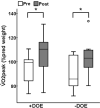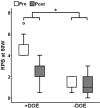Aerobic exercise training without weight loss reduces dyspnea on exertion in obese women
- PMID: 26593640
- PMCID: PMC4696905
- DOI: 10.1016/j.resp.2015.11.004
Aerobic exercise training without weight loss reduces dyspnea on exertion in obese women
Abstract
Dyspnea on exertion (DOE) is a common symptom in obesity. We investigated whether aerobic exercise training without weight loss could reduce DOE. Twenty-two otherwise healthy obese women participated in a 12-week supervised aerobic exercise training program, exercising 30 min/day at 70-80% heart rate reserve, 4 days/week. Subjects were grouped based on their Ratings of Perceived Breathlessness (RPB) during constant load 60 W cycling: +DOE (n=12, RPB≥4, 37±7 years, 34±4 kg/m(2)) and -DOE (n=10, RPB≤2, 32±6 years, 33±3 kg/m(2)). No significant differences between the groups in body composition, pulmonary function, or cardiorespiratory fitness were observed pre-training. Post-training,peak was improved significantly in both groups (+DOE: 12±7, -DOE: 14±8%). RPB was significantly decreased in the +DOE (4.7±1.0-2.5±1.0) and remained low in the -DOE group (1.2±0.6-1.3±1.0) (interaction p<0.001). The reduction in RPB was not significantly correlated with the improvement in cardiorespiratory fitness. Aerobic exercise training improved cardiorespiratory fitness and DOE and thus appears to be an effective treatment for DOE in obese women.
Keywords: Breathlessness; Cardiorespiratory fitness; Exercise; Obesity; Shortness of breath.
Copyright © 2015 Elsevier B.V. All rights reserved.
Figures



Similar articles
-
Weight loss reduces dyspnea on exertion in obese women.Respir Physiol Neurobiol. 2014 Dec 1;204:86-92. doi: 10.1016/j.resp.2014.09.004. Epub 2014 Sep 16. Respir Physiol Neurobiol. 2014. PMID: 25220695 Free PMC article.
-
Weight loss reduces dyspnea on exertion and unpleasantness of dyspnea in obese men.Respir Physiol Neurobiol. 2019 Mar;261:55-61. doi: 10.1016/j.resp.2019.01.007. Epub 2019 Jan 15. Respir Physiol Neurobiol. 2019. PMID: 30658095 Free PMC article.
-
Respiratory symptom perception differs in obese women with strong or mild breathlessness during constant-load exercise.Chest. 2014 Feb;145(2):361-369. doi: 10.1378/chest.12-2885. Chest. 2014. PMID: 23989732 Free PMC article.
-
Evaluation and management of exercise-induced dyspnea in otherwise healthy adolescents and young adults: A critical review.Paediatr Respir Rev. 2024 Mar 28:S1526-0542(24)00025-3. doi: 10.1016/j.prrv.2024.02.005. Online ahead of print. Paediatr Respir Rev. 2024. PMID: 38637185 Review.
-
Dyspnea, Orthopnea, and Paroxysmal Nocturnal Dyspnea.In: Walker HK, Hall WD, Hurst JW, editors. Clinical Methods: The History, Physical, and Laboratory Examinations. 3rd edition. Boston: Butterworths; 1990. Chapter 11. In: Walker HK, Hall WD, Hurst JW, editors. Clinical Methods: The History, Physical, and Laboratory Examinations. 3rd edition. Boston: Butterworths; 1990. Chapter 11. PMID: 21250057 Free Books & Documents. Review.
Cited by
-
Repeatability of dyspnea measurements during exercise in women with obesity.Respir Physiol Neurobiol. 2022 Mar;297:103831. doi: 10.1016/j.resp.2021.103831. Epub 2021 Dec 16. Respir Physiol Neurobiol. 2022. PMID: 34922000 Free PMC article.
-
Multidimensional aspects of dyspnea in obese patients referred for cardiopulmonary exercise testing.Respir Physiol Neurobiol. 2020 Mar;274:103365. doi: 10.1016/j.resp.2019.103365. Epub 2019 Dec 30. Respir Physiol Neurobiol. 2020. PMID: 31899350 Free PMC article.
-
Inhaled albuterol increases estimated ventilatory capacity in nonasthmatic children without and with obesity.Respir Physiol Neurobiol. 2021 Mar;285:103597. doi: 10.1016/j.resp.2020.103597. Epub 2020 Dec 7. Respir Physiol Neurobiol. 2021. PMID: 33301965 Free PMC article.
-
Sex differences in the ventilatory responses to exercise in mild to moderate obesity.Exp Physiol. 2022 Aug;107(8):965-977. doi: 10.1113/EP090309. Epub 2022 Jul 17. Exp Physiol. 2022. PMID: 35771362 Free PMC article.
-
The occurrence mechanism, assessment, and non-pharmacological treatment of dyspnea.Med Rev (2021). 2024 Apr 22;4(5):395-412. doi: 10.1515/mr-2024-0006. eCollection 2024 Oct. Med Rev (2021). 2024. PMID: 39444798 Free PMC article. Review.
References
-
- American College of Sports Medicine (ACSM) Exercise is medicine. 2015 http://www.exerciseismedicine.org.
-
- Anon. Standardization of spirometry, 1994 Update. American thoracic society. Am J Respir Crit Care Med. 1995;152:1107–1136. - PubMed
-
- Anon. NHLBI obesity education initiative expert panel on the identification, evaluation, and treatment of obesity in adults (US) Bethesda (MD): National Heart, Lung, and Blood Institute; 1998. Clinical guidelines on the identification, evaluation, and treatment of overweight and obesity in adults: the evidence report.
-
- Azagury DE, Lautz DB. Obesity overview: epidemiology, health and financial impact, and guidelines for qualification for surgical therapy. Gastrointest Endosc Clin N Am. 2011;21:189–201. - PubMed
-
- Babb TG, Ranasinghe KG, Comeau LA, Semon TL, Schwartz B. Dyspnea on exertion in obese women: association with an increased oxygen cost of breathing. Am J Respir Crit Care Med. 2008;178:116–123. - PubMed
Publication types
MeSH terms
Grants and funding
LinkOut - more resources
Full Text Sources
Other Literature Sources
Medical

